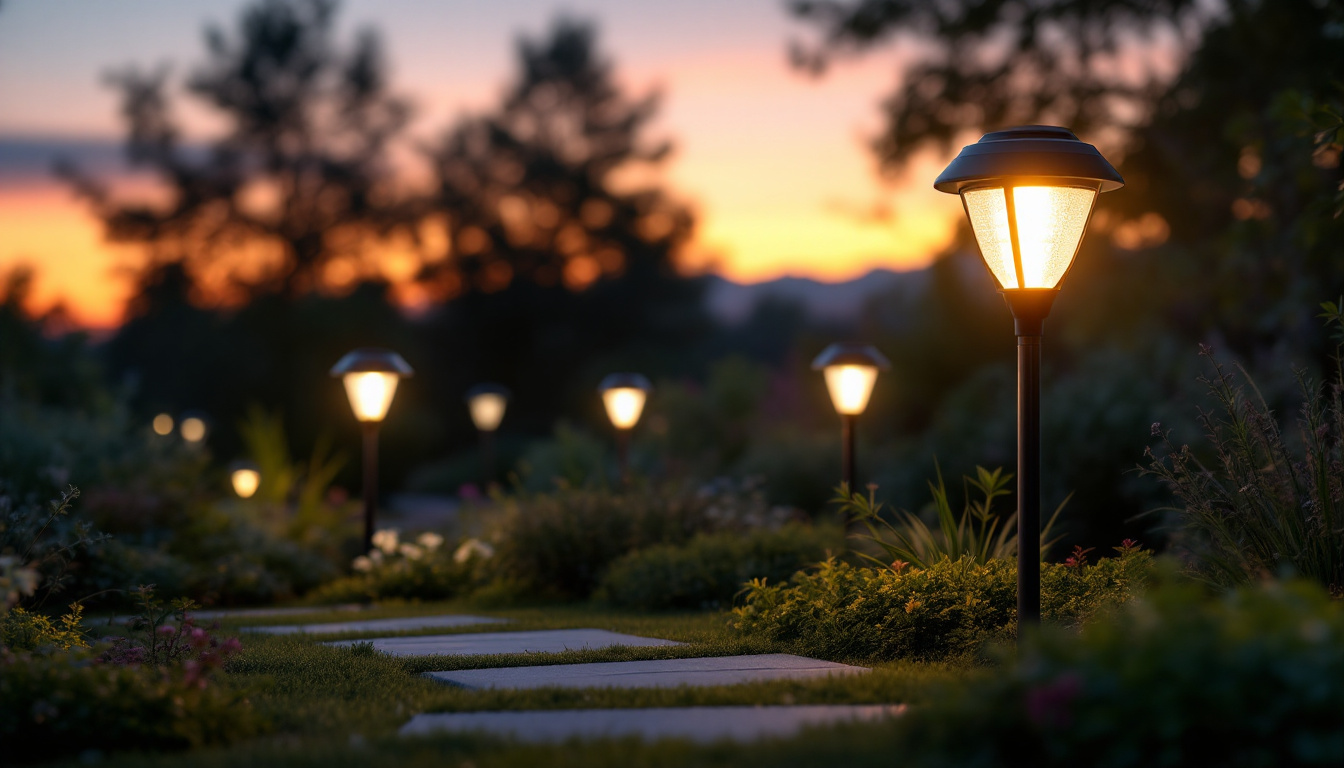
In recent years, the lighting industry has witnessed a significant transformation, particularly in the realm of outdoor lighting. The advent of LED technology, combined with solar energy, has revolutionized how outdoor spaces are illuminated. This article delves into the evolution of LED outdoor solar lights, exploring their benefits, technological advancements, and the implications for lighting contractors.
LED (Light Emitting Diode) technology has become a cornerstone in modern lighting solutions. Initially used in small applications like indicator lights and displays, LEDs have evolved to provide powerful illumination suitable for various environments, including outdoor settings. The transition from traditional lighting methods to LEDs has been driven by advancements in technology, making them more accessible and affordable for everyday consumers. As a result, they have transformed the way we think about lighting, moving from mere functionality to a key element of design and ambiance.
One of the most significant advantages of LED technology is its energy efficiency. Compared to traditional incandescent bulbs, LEDs consume considerably less power while offering the same or even greater brightness. This efficiency translates into lower energy bills and a reduced carbon footprint, making them an attractive option for environmentally conscious consumers. Furthermore, the ability of LEDs to produce light without generating excessive heat adds to their appeal, as it minimizes the risk of burns and reduces the need for additional cooling in enclosed spaces.
Moreover, LEDs boast an impressive lifespan, often lasting up to 25,000 hours or more. This longevity means fewer replacements and maintenance costs, which is a crucial consideration for lighting contractors managing large outdoor projects. The durability of LEDs also means they are less susceptible to breakage compared to traditional bulbs, making them ideal for outdoor installations that may be exposed to harsh weather conditions or physical impacts. As a result, many municipalities and businesses are making the switch to LED street lighting, which not only enhances safety but also significantly lowers maintenance expenses over time.
LEDs are available in various colors and designs, allowing for creative freedom in outdoor lighting applications. From pathway lights to decorative garden fixtures, the versatility of LED technology enables contractors to cater to diverse aesthetic preferences and functional requirements. This adaptability is particularly beneficial in landscape lighting, where the right illumination can highlight architectural features, create inviting outdoor spaces, and enhance security. The ability to customize color temperatures—from warm whites to cool blues—further allows designers to set the desired mood for any environment.
Additionally, the compact size of LEDs allows for innovative designs that were not feasible with traditional lighting options. This adaptability has led to a surge in unique outdoor lighting solutions, enhancing the visual appeal of residential and commercial spaces alike. For instance, LED strip lights can be integrated into furniture or architectural elements, creating seamless and modern lighting effects. Furthermore, advancements in smart LED technology have enabled homeowners to control their outdoor lighting through mobile apps, allowing for dynamic changes in brightness and color, which can be adjusted according to the occasion or personal preference. This level of customization not only enhances the user experience but also opens up new possibilities for creative expression in outdoor design.
As the demand for sustainable energy solutions grows, the integration of solar power into outdoor lighting has gained momentum. solar-powered LED lights combine the benefits of both technologies, creating a compelling option for outdoor illumination.
Solar-powered LED lights operate using photovoltaic cells that convert sunlight into electricity. During the day, these cells charge a battery, which powers the LEDs at night. This self-sustaining mechanism eliminates the need for wiring and reduces installation costs, making them an appealing choice for contractors.
Furthermore, the absence of electrical wiring allows for greater flexibility in placement. Solar lights can be installed in remote areas where traditional electrical access is challenging, expanding the possibilities for outdoor lighting design.
The combination of solar power and LED technology significantly reduces the environmental impact of outdoor lighting. By harnessing renewable energy, solar LED lights contribute to lower greenhouse gas emissions and a reduced reliance on fossil fuels.
For lighting contractors, promoting solar-powered solutions can enhance their reputation as environmentally responsible professionals. As more clients seek sustainable options, offering solar LED lights can position contractors as leaders in the industry.
As technology continues to advance, solar LED lights have become more efficient and user-friendly. Recent innovations have addressed many of the limitations that earlier models faced, making them a viable option for a broader range of applications.
Modern solar LED lights often come equipped with smart technology features, such as motion sensors and remote control capabilities. These advancements enhance functionality and allow for greater control over lighting conditions, improving energy efficiency and user experience.
Motion sensors, for instance, enable lights to activate only when movement is detected, conserving battery life and reducing energy consumption. This feature is particularly useful in security applications, where illumination is needed only when necessary.
Battery technology has also seen significant improvements, with newer models utilizing lithium-ion batteries that offer higher capacity and faster charging times. These advancements ensure that solar LED lights can operate effectively, even in areas with limited sunlight.
Additionally, some solar lights now feature dual charging options, allowing them to be charged via solar power during the day and through electrical outlets when necessary. This versatility ensures consistent performance, regardless of weather conditions.
The versatility of LED outdoor solar lights makes them suitable for a wide range of applications. From residential gardens to commercial properties, these lights can enhance safety, security, and aesthetics.
In residential settings, solar LED lights can illuminate pathways, driveways, and gardens, providing both safety and ambiance. Homeowners appreciate the ease of installation and the reduced energy costs associated with solar lighting.
Moreover, decorative solar lights can enhance landscaping, creating inviting outdoor spaces for relaxation and entertainment. The variety of styles available allows homeowners to choose fixtures that complement their architectural design and personal taste.
In commercial applications, solar LED lights are increasingly used in parking lots, parks, and public walkways. Their ability to operate independently of the electrical grid makes them an attractive option for municipalities and businesses looking to reduce operational costs.
Furthermore, the enhanced visibility provided by solar LED lights can improve safety in public spaces, deterring crime and ensuring that areas are well-lit for nighttime use. This is particularly important in urban environments where security is a top priority.
Despite the numerous advantages of LED outdoor solar lights, there are challenges and considerations that contractors must keep in mind when recommending these solutions to clients.
While the initial investment in solar LED lights may be higher than traditional lighting options, the long-term savings in energy costs and maintenance can offset this expense. Contractors should educate clients on the total cost of ownership, highlighting the financial benefits over time.
Additionally, clients may need reassurance regarding the performance of solar lights in varying weather conditions. Providing information on battery life, charging capabilities, and the expected lifespan of the fixtures can help alleviate concerns.
Proper site assessment is crucial for the successful installation of solar LED lights. Factors such as sunlight exposure, landscape features, and the intended use of the space must be considered to ensure optimal performance.
Contractors should conduct thorough evaluations of the installation site, recommending the best locations for solar lights to maximize sunlight exposure and minimize obstructions. This attention to detail can significantly impact the effectiveness of the lighting solution.
The future of LED outdoor solar lights appears bright, with ongoing advancements in technology and increasing consumer awareness of sustainability. As the market continues to evolve, lighting contractors must stay informed about emerging trends and innovations.
As more individuals and businesses prioritize sustainability, the demand for solar-powered lighting solutions is expected to rise. Contractors who embrace this trend and offer solar LED options will be well-positioned to meet the needs of eco-conscious clients.
Furthermore, the integration of smart technology into solar lighting systems is likely to expand, providing even more opportunities for contractors to enhance their service offerings. Staying ahead of these trends will be essential for maintaining a competitive edge in the lighting industry.
To provide the best solutions for clients, contractors should consider collaborating with manufacturers that specialize in solar LED technology. Building strong relationships can lead to access to the latest products, training, and support, ultimately benefiting both the contractor and the client.
By staying connected with industry leaders, contractors can ensure they are equipped with the knowledge and resources needed to successfully implement solar LED lighting solutions in their projects.
The evolution of LED outdoor solar lights represents a significant shift in the lighting industry, driven by advancements in technology and a growing emphasis on sustainability. For lighting contractors, understanding the benefits, applications, and challenges of these solutions is crucial for meeting the evolving needs of clients.
As the demand for energy-efficient and environmentally friendly lighting solutions continues to grow, contractors who embrace solar LED technology will be at the forefront of this transformation. By offering innovative, sustainable options, they can enhance their service offerings and contribute to a brighter, more sustainable future in outdoor lighting.
Ready to lead the charge in the sustainable lighting revolution? At LumenWholesale, we provide lighting contractors with the highest quality LED outdoor solar lights that blend innovation with sustainability. Our spec-grade lighting products come at unbeatable wholesale prices, ensuring you can illuminate your projects while maximizing value. Say goodbye to middleman markups and hello to hassle-free bulk purchasing with free shipping. Elevate your lighting solutions with the perfect combination of reliability, performance, and affordability. Discover wholesale lighting at the best value today and brighten the future with LumenWholesale.

Discover the transformative power of Lotus LED lights in this comprehensive guide.

Discover how the LED MR16 bulb is revolutionizing the lighting industry, offering contractors unparalleled efficiency, cost savings, and versatility.

Explore the innovative strategies smart lighting contractors use to integrate large pendants into modern spaces.

Discover how solar light strips can revolutionize outdoor lighting projects and give contractors a competitive edge.